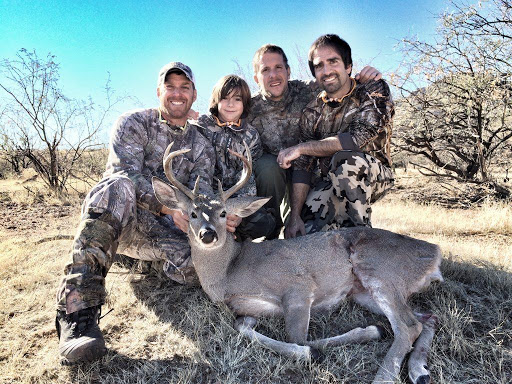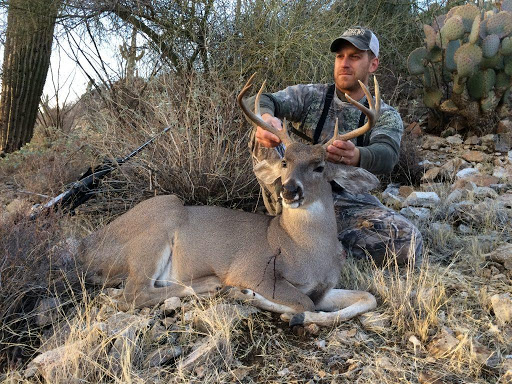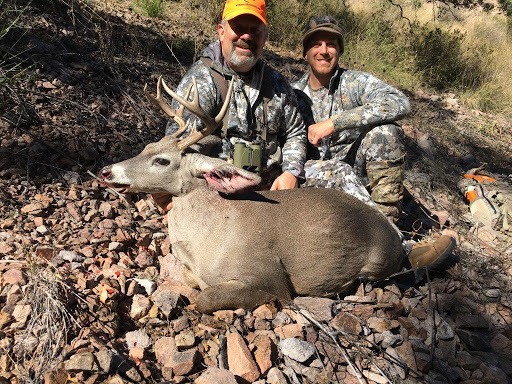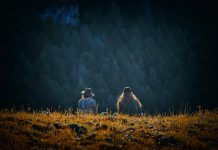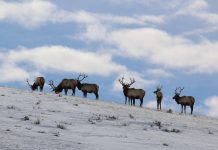If you have ever tried your luck at hunting the grey ghosts of the southwest, you know how tough it is to locate let alone harvest one of these elusive creatures. Both rifle hunters and bow hunters alike scratch their heads, in frustration while hunting these little beasts.
About the size of a large dog, 3x more skittish than your average whitetail, harsh environment, low densities, and poor hunting conditions make this the hardest whitetail and I would go out on a limb and say aside form Mt goat, Ibex and high dwelling sheep the hardest animal to bow hunt in the U.S.
Habitat
They can be found in high desert mountain ridges, juniper scrub to ponderosa stands above 6,000 feet. Highly adaptable like their Midwest cousins, these grey ghosts are well suited to survive.
Coues deer Bucks will bed more times then not on a north or northeastern slope, but can also be found many times in thick mesquite bottoms and shelves of ocotillo.
They have a home range of about 2-4 sq miles but rarely venture out of their core areas of a 1/2 mile. They tend to avoid cattle and will often feed right where they bed. During the earlier hunts its very common that a buck will occupy the same 100 yard square for the entire day, eat, poop, sleep all in the same spot.
One good aspect about this habitual little guy is once you have spotted him in his bed chances are you will find him there again on other outings.
Desert deer in general “flock” to water and develop their daily routines centering around water. 1) because everything is a meal in the desert 2) Because they will not be able to survive without permanent water sources.
Around the washes and drainages of the desert new growth is more abundant. The new growth often carries a higher water content, drawing deer to these areas. Also the growth of vegetation on the whole new and old is much greater so deer will use these areas for cover. When you are glassing the desert landscape you can always tell where the water holes and large washes are located because they will always have a higher density of trees and appear greener and thicker.
It is this combination of good cover, food and easier path to travel that make these areas good deer habitat in what otherwise would be very poor deer country. I concentrate my efforts on these areas as well as saddles, benches and in areas with high concentrations of cactus fruits. There are really only two effective ways of hunting Coues, and that’s over water and spot and stalk.
Methods of Hunting
Water hole hunting can be very trying on your patients and fruitless more often than not. Mainly because bucks in particular frequent water after or before legal shooting light, and on those days that are very hot and dry where they are forced to water more than once a day, it is miserable to say the least to sit in a ground blind in 110 deg weather. However, when they do venture into your watering hole its your best opportunity to get one killed.
But if you want to have the total experience there is no better way to hunt then spot and stalk like our ancestors did, in December and January. Spot and stalk hunting is the toughest method out there, but it is the most fun in my opinion because it’s very proactive.
One of the most common mistakes people make when pertaining to glassing is not having a system. Just having system, alone will improve the number of game you will see. One way I like to pick apart a mountainside is by first doing a quick scan going left to right and top to bottom. This way you can pick up any game that might be moving. Once I’ve done my initial scan I begin to pick apart the mountain very systematically. I start from the right top corner and move frame by frame, holding a minimum of 10 seconds per frame. I will actually count out 10 sec for the first few to kinda set a pace. But don’t keep counting because psychologically you start paying more attention to the counting and not what you’re looking at. You should be scanning within each frame the same way you are looking at the mountain. Right to left, top to bottom or vice versa. Take note to look under each tree and check the shadows real well. You may only get an ear twitch or a tail flick that alerts you to the presents of an animal.
Once you have devised your system of glassing mechanics it is time to develop good glassing habits. First save yourself the frustration and get yourself a good tri-pod set up. Something light and compact because no matter how steady you think you are glassing, off-hand is not as effective and you will tire easily. Always try to pick out your vantage point from where you will be glassing before you go hunting. Do this during your scouting or the day before if possible. This way you will know how long it will take to get there in the dark to set up before day break. This is especially important during early season where the deer or other game may only be up for an hour or two.
Picking a vantage point in itself is probably the most important aspect of them all. This for me is all dependent on what type of country I’m looking at. If I’m in the desert I like to be lower looking up. This allows me to see under the low trees and brush. If I’m in an area with spotted timber and big open areas I like to be high looking down. And in real rocky situations I like to be mid mt looking straight a crossed. Once I have picked my spot I like to figure out where the bedding and feeding areas are. At first light after I have done my initial scan. I pick the side of the mountain that consists mostly of the feeding areas and I start the process there. As it begins to warm up I may focus more on the bedding areas. Or I will try to pick out traveling lanes to bedding areas. It’s real important to be systematic because it helps you stay patient. And patience is the biggest key to being successful in the field.
Gear for Success
If you truly want to be effective with this method you need the following gear. I will list them in order of importance:
- A good pair of binoculars! Quality optics are a must! Here are my suggestions in order of preference: Swarovski, Lieca, Ziess, Nikon, Maven, and Vortex. I suggest you carry a pair of high power binos to glass from a tripod. And also carry a small pair to use while you are stalking. I glass with 15×56 Swarovski SLC HD on a tripod. I spot my game then when I make my stalk I use my 8×32 Swarovski Els. You can read my binocular review.
- Tripod: A good steady, articulate, but light tripod is a must I suggest: Monforotto 190xDB. It’s a great tripod for about $130 its medium weight and it has full articulation in the legs. Best of all it folds up small for easy storage. If you wanna step up your game Monfrotto 190CX PRO4 with MHXPRO- 2W pan head is great. It is what I use for my personal system.
- Butt Pad: Don’t laugh the desert is a nasty place and you will be pulling thorns outa your rear end for a long time if you don’t have it. Besides I find the more comfortable you are the better you are a being patient through your glassing I use the Phoenix shooting bags glassing pad.
So develop you system, get the right gear and become more successful…..See ya in the field



